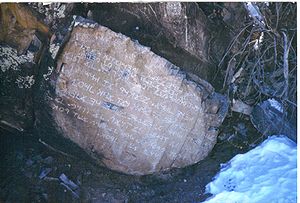Los Lunas Decalogue Stone
34°47′07″N 106°59′47″W / 34.785217°N 106.996512°W

The Los Lunas Decalogue Stone is a hoax associated with a large boulder on the side of Hidden Mountain, near
History
The first recorded mention of the stone is in 1933, when professor
The reported 1880s date of discovery is important to those who believe that the stone is pre-Columbian. However, the Paleo-Hebrew script, which is closely related to the Phoenician script, was known to scholars by at least 1870 - thus not precluding the possibility of a modern hoax.[9]

Because of the stone's weight of over 80 tons, it was never moved to a museum or laboratory for study and safekeeping. Many visitors have cleaned the stone inscriptions over the years, likely destroying any possibility for scientific analysis of the inscriptions' patina. Nevertheless, comparing it to a modern inscription nearby, geologist George E. Morehouse, a colleague of Barry Fell, estimated that the inscription could be between 500 and 2000 years old and explaining its freshness and lack of patina as being due to frequent scrubbing to make it more visible.[10]
In April 2006, the first line of the unprotected inscription was obliterated by vandals.
Visitors to the site are required to purchase a $35 Recreational Access Permit from the New Mexico State Land Office.
Controversy

Archaeolinguist
One argument against the stone's antiquity is its apparent use of modern Hebrew (or otherwise atypical) punctuation,[12] though amateur epigrapher Barry Fell argued that the punctuation is consistent with antiquity.[13] Other researchers dismiss the inscription based on the numerous stylistic and grammatical errors that appear in the inscription.[12]
According to archaeologist Kenneth Feder, "the stone is almost certainly a fake." He points out that "the flat face of the stone shows a very sharp, crisp inscription..." His main concern however is the lack of any archaeological context. He argues that to get to the location of the stone would have required whoever inscribed it to have "stopped along the way, encamped, eaten food, broken things, disposed of trash, performed rituals, and so on. And those actions should have left a trail of physical archaeological evidence across the greater American Southwest, discovery of which would undeniably prove the existence of foreigners in New Mexico in antiquity with a demonstrably ancient Hebrew material culture..." and states that "There are no pre-Columbian ancient Hebrew settlements, no sites containing the everyday detritus of a band of ancient Hebrews, nothing that even a cursory knowledge of how the archaeological record forms would demand there would be. From an archaeological standpoint, that's plainly impossible."[14]
British archaeologist Keith Fitzpatrick-Matthews has concluded that "Viewed dispassionately, the Los Lunas inscription is a clear, but well constructed forgery (for its day). Despite the claims of high antiquity, there are features of the text (such as the mixing of letter forms between two separate alphabets) that are much more likely to derive from the work of a modern forger than from an ancient Hebrew or Samaritan scribe." Other speculative origin myths include the idea that members of a passing U.S. Army battalion made up primarily of Mormon soldiers during the Mexican-American War carved the stone. [15][16]
Similar landmarks
The Los Lunas Decalogue Stone is often grouped with the
See also
- Bat Creek Inscription
- Diffusionism
- Newark Holy Stones
- Pseudoarchaeology
Notes
- ^ NM State Land Office Mystery Stone webpage
- ^ This claim is made, e.g., by Fell (1980, p. 167), Gordon (1995), Deal (1999) and Tabor (1997).
- ^ Feagans, Carl (2022-01-14). "Archaeological Fraud of the Month: Los Lunas Stone". Archaeology Review. Retrieved 2024-02-26.
- ^ Feder (2011, p. 160)
- ^ Tabor (1997)
- ^ Preston (1995).
- ^ Bliss (1940).
- ^ Dalton (2003).
- ^ Webster (1870, pp. 1766-67)
- ^ Morehouse, George E.; "The Los Lunas Inscriptions, a Geological Study," Epigraphic Society, Occasional Publications, 13:44, 1985.
- ^ Gordon (1995).
- ^ a b Keith Fitzpatrick-Matthews (6 September 2011). "The Los Lunas Inscription". Bad Archaeology. Retrieved 15 January 2014.
- ^ Fell (1985).
- ^ Feder (2011, pp. 159-62).
- ^ The Los Lunas Inscription http://www.badarchaeology.com/out-of-place-artefacts/petroglyphs-inscriptions-and-reliefs/the-los-lunas-inscription/
- JSTOR 23289247.
References
- Bliss, Wesley L., "A Chronological Problem Presented by Sandia Cave, New Mexico." American Antiquity, 1940a 5(3):200-201.
- Dalton, Rex, Dalton, R (27 November 2003). "University buildings named on shaky ground". Nature. 426 (6965): 374. PMID 14647348..
- ISBN 978-0-313-37918-5..
- Fell, Barry, Saga America, Times Books, 1980.
- Fell, Barry, "Ancient Punctuation and the Los Lunas Text," Epigraphic Society, Occasional Publications, 13:35, 1985.
- Gordon, Cyrus, "Diffusion of Near East Culture in Antiquity and in Byzantine Times," Orient 30-31 (1995), 69–81.
- Neuhoff, Juergen, and Stan Fox, "Translation of the Los Lunas Inscription" webspage dated 1999, accessed Jan. 28, 2013.
- New Mexico State Land Office, Mystery Stone, webpage, accessed Jan. 26, 2013.
- Preston, Douglas, "The Mystery of Sandia Cave," New Yorker, 71 (16, June 12, 1995):66-83.
- Tabor, James D, "An Ancient Hebrew Inscription in New Mexico: Fact or Fraud?" United Israel Bulletin, 59 (Summer 1997): 1–3. Web version crawled by Wayback Machine Dec. 2, 1998.
- Webster, Noah, American Dictionary of the English Language, G&C Merriam, 1870.
External links
- Batya Ungar-Sargon, "The Mystery Stone: Does a rock in New Mexico show the Ten Commandments in ancient Hebrew? Harvard professor says yes," Tablet (an online daily magazine of Jewish news and culture), Feb. 27, 2013.
- Fitzpatrick-Matthews, Keith, and Doeser, James, "The Los Lunas Inscription" Bad Archaeology (a website examining dubious archaeological claims), 2013.
